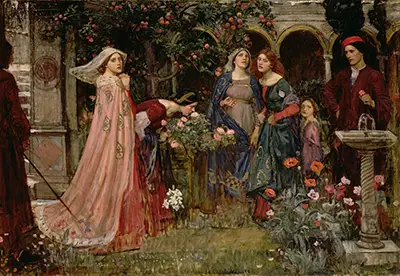Introduction
As with many of Waterhouse's paintings, there is much more to see and understand within the content of this work than what first meets the eye. It is, essentially, a garden within a garden.
There is a suggestion that this painting was aimed at providing cheer and happiness at a time when the First World War had begun. Ironically, it was that same war that was to prevent Waterhouse from ever completing this painting. Thankfully, sufficient work has been completed to allow us to still enjoy this piece today, unfinished or not.
Description
A sinister figure lurks in darkness on the left hand side of the painting, in what is otherwise a bright and lively scene. A group of four girls, plus a younger child head out into this private garden in order to enjoy the various species of flowers growing. One bends down and smells the scent of a white-headed flower.
On the right hand side a young gentleman joins them, but appears to be looking over at the mystery figure on the opposing side. There is also a charming water fountain, with sculptured features, plus an arch way at the back. Tall plants, possibly bearing fruit, are intertwined with the architecture, behind these young women.
One of the ladies, furthest to the left, wears a hood which perhaps indicates her importance in this scene. She looks across towards us, angling her head around, whilst her friends seem enchanted by this beautiful garden and seemingly unaware of the potential danger that lurks close by.
There are many influences within this scene. Some might see Roman-influence in the young man's dressing, whilst the garden feels classical in its design. Waterhouse loved British poetry plus mythical tales, and would often combine elements of them together in his charming scenes. He built up a strong following within the UK for much of his life, but interest in this style started to dwindle in his later years.
Location
This painting is owned by the Lady Lever Art Gallery, which is a part of the National Museums in the UK. As with many of his paintings, it was exhibited at the Royal Academy in the same year that it was completed. The gallery is based in the English city of Liverpool.
Waterhouse's later paintings perhaps lacked the sharpness and brilliance of early paintings (to be fair, this particular piece was unfinished) but there is still much to admire in this artwork, which features multiple female figures plus various elements of Victorian architecture.
The Lady Lever Art Gallery is particularly well known for its collection of Pre-Raphaelite artworks, though there are other items to see here too. The related artists to be found here alongside this work by Waterhouse are James Campbell, John Ingle Lee, John Everett Millais, Dante Gabriel Rossetti, William Holman Hunt and John Brett.
Large Image of The Enchanted Garden
This scene is one of John William Waterhouse's most complex. There are seven figures in total, all but one with considerable detail from head to toe. There is also an abundance of life in this private garden, with shrubs and flowers adorning the composition alongside various architectural elements. It is classic Waterhouse, and the larger image below should help you to appreciate more of the detail added by the artist.


